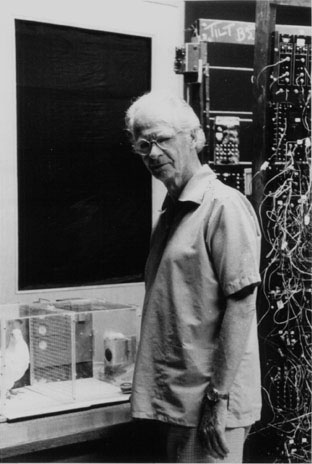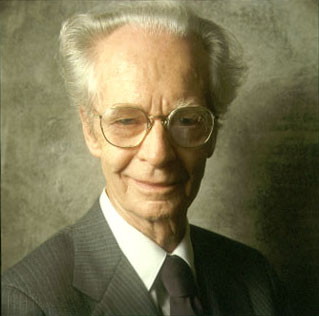 |
||
| | Home | SKINNER early years | SKINNER, college years | SKINNER explains behaviorism & choice-- briefly | SKINNER, brief biography | I was not a Lab Rat--Deborah Skiner | Skinner on Programmed Instruction | Skinner on mind and wanting | Skinner: "Why I am Not a Cognitive Psychologist" | QUOTES & LINKS | Skinner's philosophy of mind--prof. Brown | |
|
B.F. SKINNER, works and life |
|
|
Skinner on Programmed Instruction |
|
|
A Hypertext History of Instructional
Design http://www.coe.uh.edu/courses/cuin6373/idhistory/skinner.html While Pressey had invented and demonstrated a testing machine
as early as 1925, it was B.F. Skinner's elaboration of the theory of reinforcement and its application to learning
that established the Programmed Instruction Movement. Skinner's Frames of Instruction A set of frames designed to teach a third-or fourth-grade pupil to spell
the word manufacture. {Each of the frames would appear separately and require the correct answer before progressing
to the next frame—jk}
|
||||||||||||||||||||||||
|
Frame 1 MANUFACTURE means to make or build. Copy the word here: ___ ___ ___ ___ ___ ___ ___ ___ ___ ___ ___ Frame 2 Part of the word is like part of the word FACTORY. M A N U ___ ___ ___ ___ U R E Frame 3 Part of the word is like part of the word MANUAL. ___ ___ ___ F A C T U R E Frame 4 The same letter goes in both spaces. M ___ N U F ___ C T U R E Frame 5 The same letter goes in both spaces. M A N ___ F A C T ___ R E Frame 6 Chair factories B. F. Skinner Burrhus Frederic Skinner(1904-90) was a psychologist. Born in Susquhanna,
Pa., he studied at Harvard, teaching there from 1931-6 and again from 1947-74. A leading behaviorist, he was a proponent of
operant conditioning, and the inventor of the Skinner box for facilitating experimental observations. Research for testing and instruction continued
to be piecemeal until the work of B.F. Skinner. Skinner's research was in stimulus-response and reinforcement. His research
contributed to an understanding of the usefulness and application of teaching machines. He stated that, although positive
reinforcement has been proven important in learning, schools use little reinforcement but instead use aversive control. Skinner
(1954) also noted that the learning process should be divided into "a very large number of very small steps and reinforcement
must be contingent upon the accomplishment of each step." Skinner also stated that by making the steps of learning small,
the frequency of reinforcement can be increased and the frequency of being wrong is reduced. In order to accomplish the goal of positive
reinforcement delivered frequently to reward small steps in the learning process, Skinner suggested using mechanical devices.
He noted that the teacher was not able to succeed in implementing increasing reinforcement because of the limitations of class
size and styles of teaching and grading being used. Skinner (1954) stated: If the teacher is to
take advantage of recent advances in the study of learning, she must have the help of mechanical devices. The technical problem
of providing the necessary instrumental aid is not particularly difficult. There are many ways in which the necessary contingencies
may be arranged, either mechanically or electrically...The important features on the device are these: Reinforcement for the
right answer is immediate. The mere manipulation of the device will probably be reinforcing enough to keep the average student
at work for a suitable period each day, provided traces of earlier aversive control can be wiped out. A teacher may supervise
an entire class at work on such devices at the same time, yet each child may progress at his own rate, completing as many
problems as possible within the class period. If forced to be away from school, he may return where he left off. The gifted
child will advance rapidly, but can be kept from getting too far ahead either by being excused from arithmetic for a time
or by being given special sets of problems which take him into some of the interesting by-paths of mathematics. The device
makes it possible to present carefully designed material in which one problem can depend upon the answer to the preceding
and where, therefore the most progress to an eventually complex repertoire can be made. ( p. 95) Skinner concluded with
the theory that the proposed changes would free the teacher for more important functions and that mechanized instruction should
be integrated into all schools, not as a replacement for, but as an adjunct to the teacher. Skinner (1958) later developed a machine
that was built on Pressey's model but differed in several ways. He stated that a teaching machine should have several important
features. First, the student should compose his response rather than select it from a set of possible answers. Skinner supported
this idea with the fact that responses should be recalled, not simply recognized, and that wrong selections may seem out of
place and strengthen unwanted recall. Second, Skinner stated that a teaching machine should present information in a carefully
designed sequence of steps. Skinner also noted that the machine itself
does not teach, but brings the student into contact with the person who composed the material it presented. The machine is
a labor-saving device because it can bring one programmer into contact with an infinite number of students. Skinner (1958) compared
his teaching machine to a private tutor. The machine induces sustained activity while keeping the student active and busy
and would not allow the student to proceed unless he understands the materials. The material is presented in sequence as the
student is ready to receive it. The machine helps the student arrive at the correct answer both by a logical presentation
of material and by "hinting, prompting, suggesting, and so on, derived from an analysis of verbal behavior" (1958, p. 971).
Finally Skinner stated that the machine reinforces the student for every correct response with immediate feedback. Another important part
of Skinner's research included the program that the teaching machine contained. Skinner developed the concept of nearly errorless
learning through two ideas - prompting and fading. Prompting was used to construct the correct or desired response; fading
was the gradual withdrawing of stimulus supports. Both techniques were used to promote efficient learning. Skinner's ideas launched
the programmed instruction movement in the United States. Skinner's ideas attracted many followers who embraced the idea of
programmed instruction as the first truly efficient method of learning.
|
||||||||||||||||||||||||
|
Enter supporting content here |
||||||||||||||||||||||||

